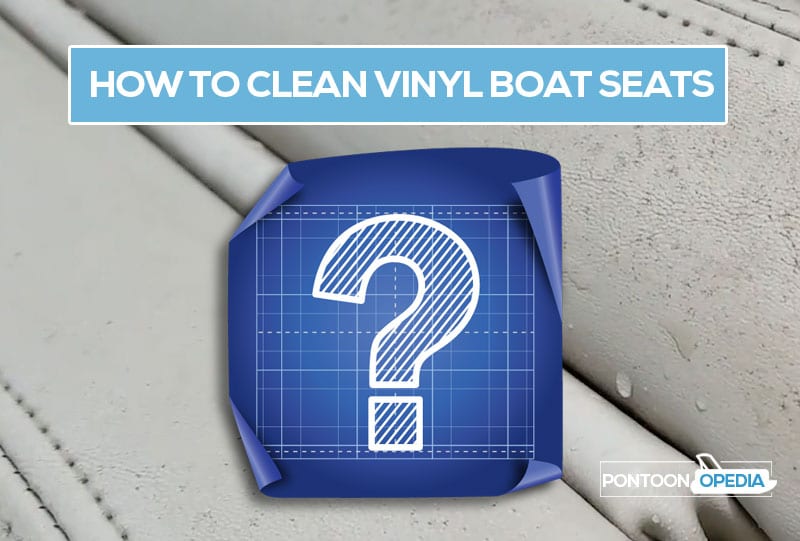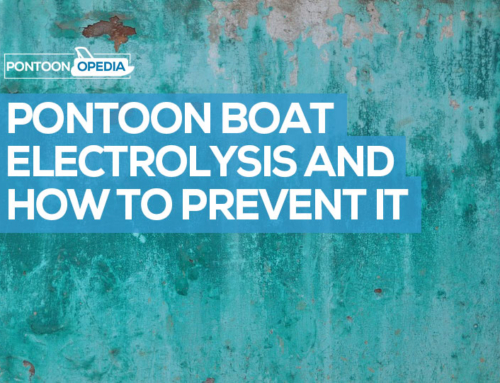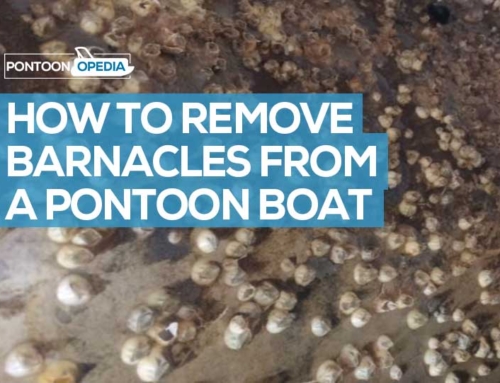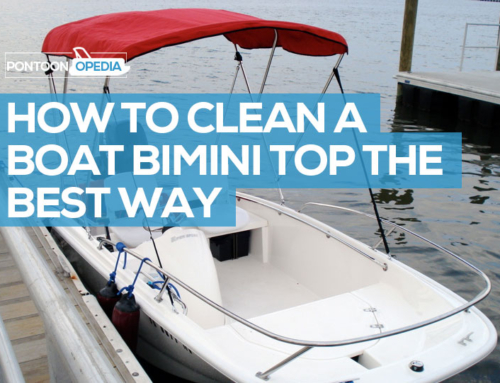A few months ago, I published a guide on how to remove mildew stains from vinyl boat seats on a pontoon. Such was the popularity of that cleaning guide, that I decided to put together some additional notes and guidance that can be used by any boat owner who needs help removing mildew from vinyl boat seats. Here’s the quick answer, followed by an in-depth tutorial including what cheap products you need.
Spray CLR mold and mildew stain remover over the vinyl boat seats and leave for 5 minutes. Then take a soft brush, use scrub lightly to loosen up mold and dirt, and wipe away with a microfiber cloth. Repeat this step as many times as you can, then with any remaining stubborn mold, wipe gently with a Magic Eraser.
That process above is the best way to remove mildew from boat seats and should give you excellent results. But, there are some aspects which I need to go into a little bit more detail on, as it is possible to damage and harm the vinyl, especially the upholstery seams.
Read on for the guide in full, with everything that you need to know with a method that won’t damage your upholstery and seats. I consider it the best homemade vinyl cleaner for boat seats, as the solution is so cheap, and beats anything you would do yourself.
Removing mildew from boat seats in 5 steps
Your boat is an expensive investment which you take great care of. But it’s the vinyl seating that is most at risk, particularly on open deck boats where water can lead to mold and mildew developing, leaving nasty black and sometimes orange stains.
Mildew will develop very quickly, particularly if you don’t wipe the seat’s down after a day of fishing or entertaining on the water – sometimes it’s the last thing that you have time to do.
The cleaning products you need:
- Box of large Magic Eraser sponges (view now on Amazon)
- CLR Mold and Mildew stain remover (view now on Amazon)
- 303 marine and UV protectant spray (view on Amazon)
- Microfiber cloth (view on Amazon)
How to remove mildew stains from vinyl boat seats
Now you have everything you need, follow these exact step by step instructions.
Step 1: Spray CLR Mold Remover onto the seats
Previously I used alternative mold removers to try cleaning up the vinyl, but nothing has ever come close to the CLR stuff. I hate mildew stains, but this cleaner is my main ammunition when it comes to getting rid of and removing the mold.
It’s outstanding stuff, and you can almost ignore any bad reviews you see online, as I believe most of the negative stuff is from people who use it to clean houses, not boat seats.
All you do is spray it over the seat, and even into the gaps and seams.
Now this is important, because it has no bleach in it. Bleach can ruin upholstery seams, and over time, if you use bleach the seams will fray and eventually come out completely.
Leave it on for 5 minutes, longer if you feel it needs it.
Step 2: Use a soft brush and scrub lightly
Once the CLR mold and mildew remover has had time to take effect, and in most cases I have found that 5 minutes seems to be the best amount of time to leave it, you can start to softly scrub it away.
I use a soft brush, and don’t go too hard, as I don’t want to mark the vinyl.
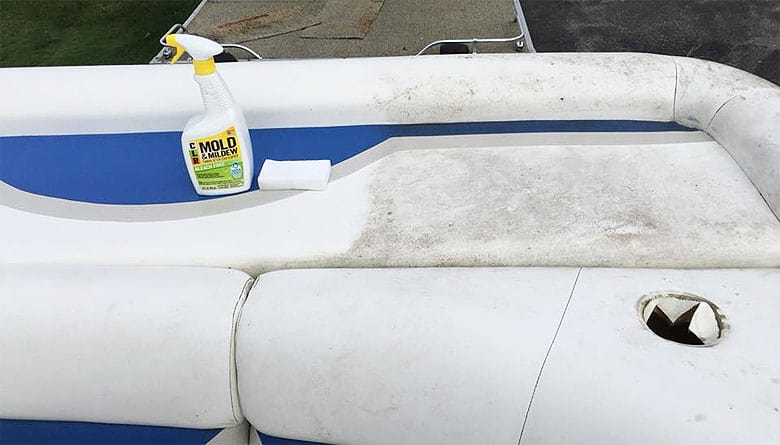
CLR mold and mildew remover can get very quick results as you can see.
I find that this approach will take off the bulk off the mildew stains and dirt, but will end up rubbing the removed debris around the vinyl come a bit, which is where the next step comes in.
Step 3: Wipe away mildew debris with a microfiber cloth
Removing mildew from the boat seats is next, and for that you can wipe away using a microfiber cloth. That should get rid of most of the mildew and mold.
I use circular motions and also push my finger into one of the cloth ends to get into all the nooks, crannies, and seams between the seats, including the stitching.
When I get asked “how to clean vinyl boat seats of mildew” I always recommend that you repeat steps 1 to 3 until you get to a point where you can’t get anything else off.
But it probably won’t be enough, which is where step 4 comes in.
Step 4: Use the Magic Eraser for the really stubborn stains
If you have left your boat unattended or in storage for some time, you’re going to have really bad mildew and mold, and you probably won’t remove all of it using steps 1 to 3.
You need more power.
And that’s what the Mr. Clean Magic Eraser gives you. It’s like taking a bazooka to a gun fight.
Using soft motions, work the Magic Eraser into the remaining vinyl mildew, and it should then all completely remove and be clean.
Unlike your brush, it can get down into the really troublesome seams and gaps in your seats, and when you wipe with it, you should see the mildew come off in one stroke
It’s awesome stuff.
Handy Hint: Mr. Clean Magic Eraser can be abrasive if you are too over enthusiastic Don’t push down too hard as this is where you could end up damaging and harming the vinyl. Just make some light pressure smooth cleaning movements and it will work fine.
You might need to repeat this process a few times with the Magic Eraser, but once finished you should be mildew-free. The photo below shows you an example of the type of results you might get using Magic Eraser on boat vinyl.
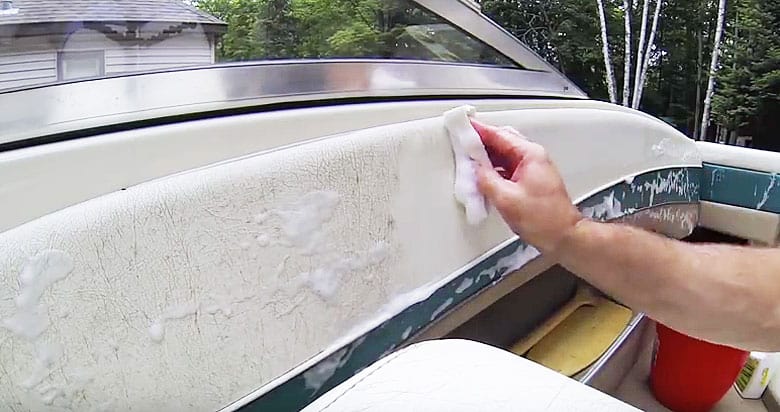
How to remove mildew from vinyl boat seats using the Magic Eraser.
Once done, use a clean microfiber cloth to remove any remaining residue, damp, or cleaning fluid.
Step 5: Use 303 Protectant to seal and protect the vinyl
This final step is optional, but definitely recommended if you want a great finish, and also want to help protect mildew from re-appearing on the vinyl.
Not only that, but it’s also a UV protectant so will help to protect the seats against the sun, including discoloring, fading, cracking, and premature aging.
Given the price of vinyl boats seats or having them repaired, it’s a no-brainer to take this final step.
Don’t Use a bleach-based cleaner
You might see other forums and websites that recommend you use diluted bleach for cleaning mildew off vinyl boat seats.
Don’t do this!
If you use anything with bleach then it can take out all the oils in the fabric and stitching,and over time the stitches will start to degrade and come apart.
Other forums and websites might also recommend a product called “The Works” which is a toilet cleaner.
Do not use it for cleaning vinyl seats.
Admittedly this is great for cleaning up things such as aluminum as you can see in this other Pontoonopedia guide, but it’s still a bleach-based product and it will ruin your interior upholstery fast.
Don’t create a homemade vinyl boat cleaner for boat seats
Whilst you might be tempted to create your own solution, it’s easy to get it wrong and damage your vinyl. I have written a guide on homemade vinyl boat seat cleaners, but I honestly believe the best approach is the one outlined above.
Removing mildew from boat carpet
I also wanted to share with you a quick tip on how you can also clean up mildew and mold from a boat carpet, where you have fabric flooring rather than vinyl.
The best method I have used in the past is to use a product called Wet and Forget carpet cleaner. I’ve used it on my pontoon and also on a house boat and it gives excellent cleaning results.
This spray is a mix of hydrogen peroxide and water, but with some added elements (I am not sure what), but it won’t bleach the carpet or upholstery. From what I read, this is exactly the same approach that many people used after Hurricane Katrina and it works well on all wet environment applications.
Once you have got rid of the boat carpet mold, you want to treat it to reduce the chances of the mold coming back in the future.
The best mold treatment product I have used is called Mold Control. You can buy a gallon on Amazon, and then using a cheap water sprayer, place it down on the affected area.
Facebook comments & feedback
After the success of my original article on the best way to clean mildew off boat seats on a pontoon, I asked for some feedback and comments on Facebook. Here’s a short selection of that feedback from other boat owners.
“I was really grateful when you published the vinyl boat seat cleaning mildew guide. I had tried other method, scrubbed hard, and even pressure washed but with zero results. This works perfectly and I am no longer embarrassed about inviting people on board.”
“Magic Eraser definitely removes the mildew, but it and other bleaching cleaners are very bad for the vinyl so don’t scrub too hard. Once it’s all dry apply the 303 protectants. It’s a simple but very affective cleaning method thank you.”
“I did use a bleach cleaner, and it ate away seam threads! So, if you do decide to use a bleach then make sure to dilute a lot with water and remove it instantly. Follow that up with the 303 and you should be fine.”
“I actually have leather seats on my boat, and bleach seems to be fine. If in doubt, try out a small spot first that you can’t see like under the seat. I wouldn’t use the diluted bleach method on cloth or vinyl boat seats though.”
“This dollar mold and mildew remover works like a charm and is honestly the best thing that I have ever used. It does not harm stitches and cleans mildew up the best from my own experience.”
“I have just used CLR mold and mildew remover and sprayed it on, then let sit for 10 minutes. I used a soft scrub brush to loosen the mold and dirt then wiped off with microfiber and water. Repeat! After that I then took the Magic Eraser and wiped gently on anything remaining. Worked excellent!”
“For best results use a couple of boxes of the large Magic Erasers, then water, 303 Protectant and some elbow grease. I agree to not use anything that has bleach in it as it will weaken the stitching in your boat seats.”
“I know everyone says it’s the devil, but I use bleach and car soap every spring on my seats. This is my eighth season with my Suntracker Party barge 21′ and the vinyl on the seats looks as good as new. No chalky, dried out vinyl, looks nice and shiny! Boat is stored in covered storage year-round.”
“I had great success with first using CLR mold and mildew remover and then rinsed and used a Magic Eraser lightly on anything tough left over. And then rinsed again. This combination got off 99% of the mold from my vinyl.”
Conclusion
I am as guilty as the next boat owner when it comes to drying off and wiping down my seats at the end of a boat trip. I get lazy, we all do.
But that’s where the mildew starts to happen.
If you can take that extra effort after each day, you should reduce the chances of having to go through the process of removing mildew from your vinyl boat seats.
It still will happen though, no matter how careful you are to remove damp. After all, you’re in the water, people are wet, splashes occur, and all that damp can get into the upholstery creases and padding.
The step by step instructions detailed above should help with:
- Mildew and mold that appears on vinyl
- Stubborn orange stains on vinyl boat seats
If you take these steps then it should mean that your vinyl seating keeps cleaner and stays in a better condition for longer, saving you a bill in the future to buy replacement covers or materials or doing a DIY upholstery project. The process above will also save you time in trying to create your own homemade vinyl cleaner for your boat seats.
Thank you for reading!
Please share on your social networks
I run Pontoonopedia in my spare time and offer advice that has worked from my own personal perspective. I do love it when I hear positive stories of people that I have helped.
So, if you have found this guide to removing mildew from boat seats then please do “pay it forward” and share on social media, or reference it in other boating forums you might be active in.

